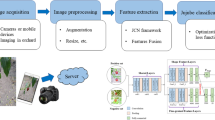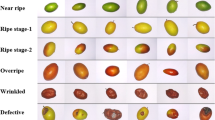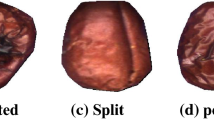Abstract
Assessment of crop maturity and quality is pivotal in the food industry and for harvesting. The manual classification of crops based on their maturity levels for harvesting and packaging purpose is a tedious process. However, the emergence of machine learning/deep learning techniques has opened up the ways in this direction, but its practical success is still limited. In this research, we examined two convolutional neural network paradigms (i.e., AlexNet and VGG16) utilizing a transfer-learning approach for classifying the jujube fruits based on their maturity level (i.e., unripe, ripe, and over-ripe). The training/testing of models was performed over the collected dataset of around 400 images, which was further augmented to 4398 images collectively for the three maturity classes. The best accuracy achieved for the correct classification of maturity classes with AlexNet and VGG16 for the actual and augmented images are 94.17% & 97.65%, and 98.26% & 99.17% respectively. The examined models were compared with two existing methods for jujube maturity classification and found to be performing better. The significantly improved success rate of VGG16 models over the AlexNet and existing proposed models for jujube classification makes the model recommendable for developing an efficient system for the automated harvesting and sorting of jujube fruits.







Similar content being viewed by others
Abbreviations
- ML:
-
Machine learning
- DL:
-
Deep learning
- CNN:
-
Convolutional neural network
- ANN:
-
Artificial neural network
- AlexNet:
-
Alex network
- VGG16:
-
Visual geometry group (16 Layers)
- BPNN:
-
Back-propagation neural network
- KNN:
-
K-nearest neighbour
- DT:
-
Decision tree
- GMM:
-
Gaussian mixture model
- SVM:
-
Support vector machine
- KPCA:
-
Kernel-principal component Analysis
- ELM:
-
Extreme learning machine
References
Pareek S (2013) Nutritional composition of jujube fruit. Emirates J Food Agric 25(6):463–470. https://doi.org/10.9755/ejfa.v2516.15552
Rashwan AK, Karim N, Rezaul M, Shishir I, Bao T, Lu Y (2020) Jujube fruit: apotential nutritious fruit for the development of functional food products. J Funct Foods 75(866):104205. https://doi.org/10.1016/j.jff.2020.104205
Magwaza LS, Tesfay SZ (2015) A review of destructive and non-destructive methods for determining avocado fruit maturity. Food Bioprocess Technol 8(10):1995–2011. https://doi.org/10.1007/s11947-015-1568-y
Li B, Lecourt J, Bishop G (2018) Advances in non-destructive early assessment of fruit ripeness towards defining optimal time of harvest and yield prediction–a review. Plants 7(1):1–20. https://doi.org/10.3390/plants7010003
Bhargava A, Bansal A (2021) Fruits and vegetables quality evaluation using computer vision: a review. J King Saud Univ-Comput Inf Sci 33(3):243–257. https://doi.org/10.1016/j.jksuci.2018.06.002
Zhu L, Spachos P, Pensini E, Plataniotis KN (2021) Deep learning and machine vision for food processing: a survey. Curr Res Food Sci 4:233–249. https://doi.org/10.1016/j.crfs.2021.03.009
Krizhevsky BA, Sutskever I, Hinton GE, ImageNet classification with deep convolutional neural networks, 2012.
Simonyan K, Zisserman A (2015) Very deep convolutional networks for large-scale image recognition. ICLR 2015:1–14
Mahendran R, Gc J, Alagusundaram K (2012), Application of computer vision technique on sorting and grading of fruits and vegetables, 1–7, https://doi.org/10.4172/2157-7110.S1-001.
Ramos RP et al (2021) Non-invasive setup for grape maturation classification using deep learning. J Sci Food Agric 101(5):2042–2051. https://doi.org/10.1002/jsfa.10824
Ohali YA (2011) Computer vision based date fruit grading system: design and implementation. J King Saud Univ-Comput Inf Sci 23(1):29–36. https://doi.org/10.1016/j.jksuci.2010.03.003
Lara-espinoza EM, Trejo-duran M, Lizarraga-morales RA (2016) Determination of the ripeness state of guavas using an artificial neural network. Res Comput Sci 121(1):105–111. https://doi.org/10.13053/rcs-121-1-9
Bazán K, Avila-george H, Member S (2019), Classification of cape gooseberry fruit according to its level of ripeness using machine learning techniques and different color spaces, 27389–27400, https://doi.org/10.1109/ACCESS.2019.2898223.
Xu Z, Yuan P, Zhang Y, Deng X (2019) Watermelon ripeness detection via extreme learning machine with kernel principal component analysis based on acoustic signals. Int J Pattern Recognit Artif Intell. https://doi.org/10.1142/S0218001419510029
Mavi MF, Husin Z, Ahmad RB, Yacob YM, Farook RSM, Tan WK (2019) Mango ripeness classification system using hybrid technique. Indones J Electr Eng Comput Sci 14(2):859–868. https://doi.org/10.11591/ijeecs.v14.i2.pp859-868
Nandi CS, Tudu B, Koley C, Machine vision based techniques for automatic mango fruit sorting and grading based on maturity level and size, In: Sensing technology: current status and future trends II,27 smart sensors, Measurement and instrumentation, no. January, Springer International Publishing Switzerland, 2014.
Mazen FMA, Nashat AA (2019) Ripeness classification of bananas using an artificial neural network. Arab J Sci Eng 44:6901–6910. https://doi.org/10.1007/s13369-018-03695-5
Saranya N, Srinivasan N, Kumar SKP (2021) Banana ripeness stage identification: a deep learning approach. J Ambient Intell Humaniz Comput. https://doi.org/10.1007/s12652-021-03267-w
Mohammed O et al (2012) Classification of oil palm fresh fruit bunches based on their maturity using portable four-band sensor system. Comput Electron Agric 82:55–60. https://doi.org/10.1016/j.compag.2011.12.010
Ni J, Gao J, Li J, Yang H, Hao Z, Han Z (2021) E-AlexNet: quality evaluation of strawberry based on machine learning. J Food Meas Charact. https://doi.org/10.1007/s11694-021-01010-9
Kumari S, Kumar A, Kumar P (2020), Maturity status classification of papaya fruits based on machine learning and transfer learning approach, Inf. Process. Agric., no. xxxx, https://doi.org/10.1016/j.inpa.2020.05.003.
Tabik S and Peralta D (2017), A snapshot of image pre-processing for convolutional neural networks: case study of MNIST, 10, 555–568.
Solem JE, Programming computer vision with python. 2012.
Hawkins DM (2004) The problem of overfitting. J Chem Inf Comput Sci 44(1):1–12. https://doi.org/10.1021/ci0342472
Shorten C, Khoshgoftaar TM (2019) A survey on image data augmentation for deep learning. J Big Data. https://doi.org/10.1186/s40537-019-0197-0
Sharif A, Hossein R, Josephine A, Stefan S and Royal KTH, CNN features off-the-shelf: an astounding baseline for recognition.”
Salvador A, Zeppelzauer M, Manch D, Calafell A, Politecnica U and Upc DC, Cultural event recognition with visual convnets and temporal models.
B. C. B, V. M. B, O. Beijbom, Hoffman J and Darrell T (2016), Best practices for fine-tuning visual classifiers, pp. 435–442, https://doi.org/10.1007/978-3-319-49409-8.
Roshan JV, Akhil V (2021) SPlit: an optimal method for data splitting. Technometrics. https://doi.org/10.1080/00401706.2021.1921037
Rahimi A, Banakar A and Zareiforoush H (2014), Classification of jujube fruits using different data mining methods, no. January. 52–61.
Cao Xiao-feng SB, Hui-ru REN, Xing-zhi LI, Ke-qiang YU (2018) Discrimination of winter jujube’s maturity using hyperspectral technique combined with characteristic wavelength and spectral indices. Spectrosc Spectr Anal 38(7):2175–2182. https://doi.org/10.3964/j.issn.1000-0593(2018)07-2175-08
Acknowledgements
This research work received no specified grant funding from any funding agency, commercial, or not-for-profit sectors. The authors express their gratitude in advance to the reviewers for their significant suggestions and comments.
Author information
Authors and Affiliations
Contributions
A.M contemplated the structure of the article, performs the experimental works, and accomplished the paper writing. AKT and SKS were involved in the suggestions and final revision of the article. All authors have read and approved the manuscript.
Corresponding author
Ethics declarations
Conflict of interest
The authors declare no conflict of interest.
Additional information
Publisher's Note
Springer Nature remains neutral with regard to jurisdictional claims in published maps and institutional affiliations.
Rights and permissions
About this article
Cite this article
Mahmood, A., Singh, S.K. & Tiwari, A.K. Pre-trained deep learning-based classification of jujube fruits according to their maturity level. Neural Comput & Applic 34, 13925–13935 (2022). https://doi.org/10.1007/s00521-022-07213-5
Received:
Accepted:
Published:
Issue Date:
DOI: https://doi.org/10.1007/s00521-022-07213-5




